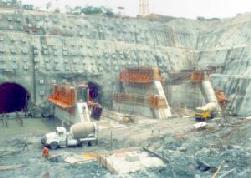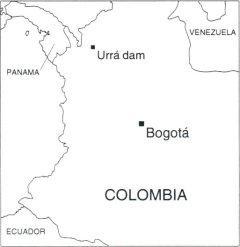 http://ens.lycos.com/ens/feb99/1999L-02-10-01.html
http://ens.lycos.com/ens/feb99/1999L-02-10-01.html http://ens.lycos.com/ens/feb99/1999L-02-10-01.html
http://ens.lycos.com/ens/feb99/1999L-02-10-01.html
more lecture:
The Embera Katio people fighting against the Urrá Dam Mega-Project
BOGOTA, Colombia, February 10, 1999 (ENS) - Amnesty International has issued an urgent alert claiming that paramilitary forces have killed six indigenous people of the Embera Katio community who are protesting the construction of a hydroelectric dam on the Sinu River. Ten others have been abducted, Amnesty International representatives say.
 350 MW Urra dam under construction (Photo courtesy Consultoria Colombiana S.A.)
350 MW Urra dam under construction (Photo courtesy Consultoria Colombiana S.A.)
Those killed on January 29 and December 24 are: Alejandro Domico, Argemiro Domico, Euclides Domico, Abelardo Bailarin, Pedro Luis Bailarin and Guillermo Bailarin.v On January 29, a paramilitary force entered the Embera Katio community of Kipardo in the Resguardo Karagabi, Karagabi indigenous reserve, forcing families to leave their homes and warning that the region could no longer escape the counter-insurgency war. On January 31, the paramilitary group set up a checkpoint on the river Sinu, which runs through the reserve, in Cordoba department, and apparently abducted 10 members of the community, whose whereabouts are now unknown.
The names of those who have disappeared are: Gabriel Domico, Solangel Arias Domico, Eugenio Domico, Lubertin Cabrera, Luz Marina Domico, Antonio Domico, William Domico, Libardo Domico, Micaela Domico and Ana Luz Guasaruca.
 Embera woman (Photo courtesy Panama Discovery Tours)
Embera woman (Photo courtesy Panama Discovery Tours)
The Embera's problems began in 1993 with the construction of the Urra hydroelectric dam on the Sinu river. The work already done has devastated the river's fish population, one of the Indians' main sources of food. If the dam were to be completed, much of their land would be flooded and their livelihood destroyed, according to the London, England based international tribal rights organization, Survival International.
The company organizing the hydroelectric project is the state-owned Urra S.A., who have contracted the Swedish company Skanska and the Russian firm Energomachiexport to build the dam.
Although Urra S.A. had agreed compensation with the Embera, the company later reneged on the arrangement. The Indians went to court to try to halt the project, and succeeded in getting an injunction preventing the completion of the dam.
 (Map courtesy Survival International)
(Map courtesy Survival International)
Local land-owners, who stand to gain financially from the dam, brought in a paramilitary group, "Cordoba and Uraba Self-Defence," with what Survival International calls "the tacit support of the provincial authorities and the army."
One of the most important Embera leaders, the 60 year old Alonso Dominco Jarupia, was fatally shot outside his house August 25, 1998.
On Novemeber 10, 1998, the Colombian Supreme Court ruled in the Indians' favour, meaning that the project can now only be completed with the Indians' consent. The paramilitaries have threatened to carry out a massacre should the dam not go ahead, Amnesty International and the National Non-governmental Indigenous Organization say.
 Figure from the Sinu River indigenous people, ca. 200 BC-600 AD (Photo courtesy Wayuu Craft Arts)
Figure from the Sinu River indigenous people, ca. 200 BC-600 AD (Photo courtesy Wayuu Craft Arts)
The Embera indigenous people live in the Darien Gap region of Panama and in northern Colombia much as they have for centuries.
International human rights and environmental groups Survival International and USA based Global Response have joined Amnesty International in calling for a halt to violence against the Embera Katio community.
Plan Puebla Panama | Dam Protests | Water Campaign | www.agp.org | www.all4all.org